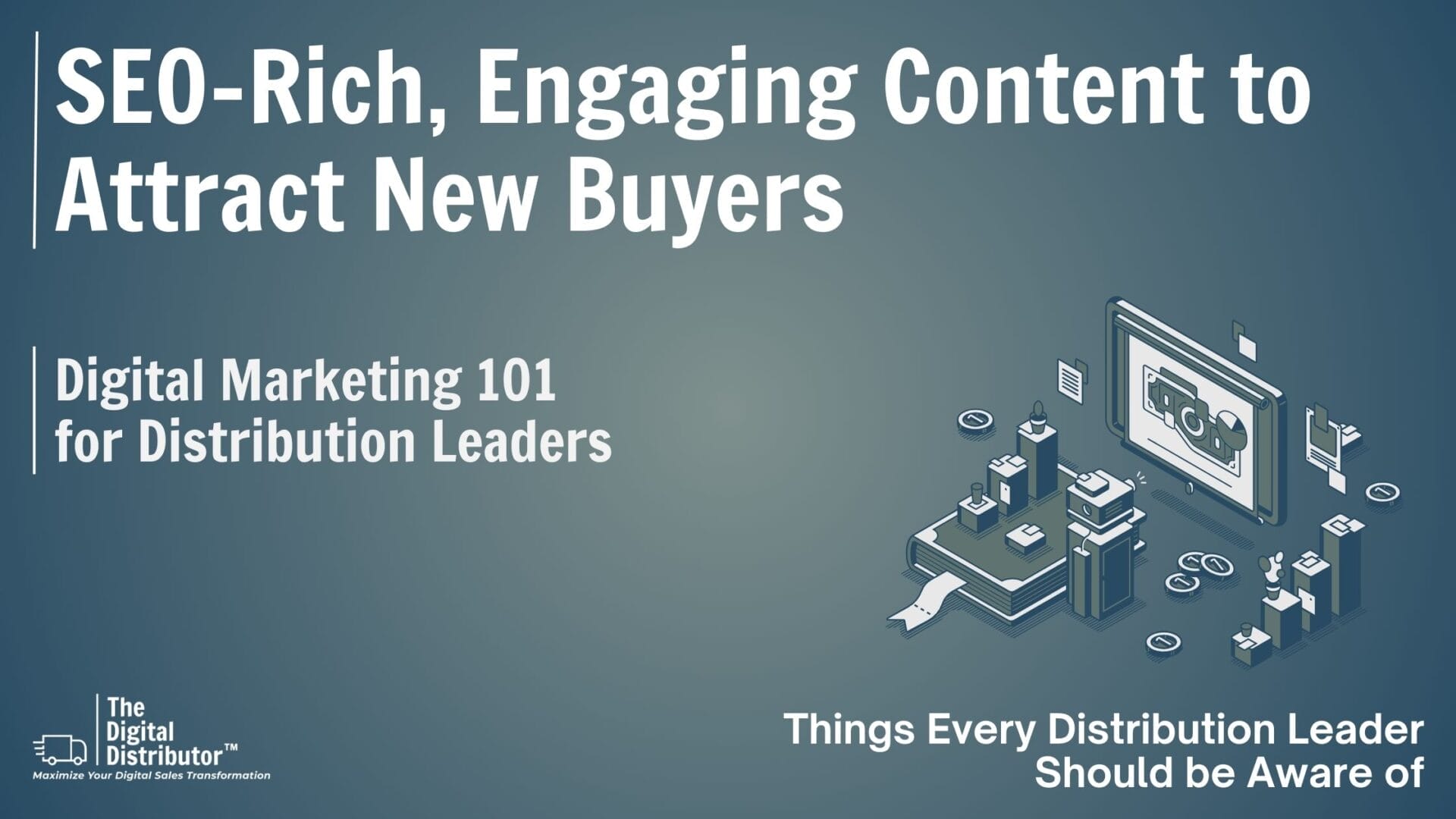Distributors and manufacturers will benefit from this “Digital Marketing 101” mini-series I put together, containing some basic elements to look for as you gauge your digital marketing capabilities. Don’t expect them all to be in place, but a small handful of any would be a great start. I hope you find the series helpful!
Website content matters. A lot. It is one of the main ways you, as a distributor, can communicate with your buyers, and it’s often the first place a new buyer will look to decide whether they’d like to work with you. So, content must be presented so that your company’s most important points are keyword-rich to make sure your buyers find you. In addition, your website must be filled with high-quality content focused on your ideal customers to keep buyers engaged. Doing so will lead to increased conversion rates, aka sales.
Making Good Website Content Great
 Many things can turn good content into great content; three of the most important are relevance, usefulness, and originality.
Many things can turn good content into great content; three of the most important are relevance, usefulness, and originality.
Relevance. Publishing relevant content is essential. Your content should matter to your audience, and it should be presented in a way that keeps them engaged and addresses their goals or pain points. Also, what is evident to you may be less apparent to your reader, so clearly state why your content is relevant to your audience.
Usefulness is what will keep buyers and readers coming back to your website. Free advice on how to improve my business? Yes, please! Remember, as a distributor, you are in the business of keeping your customers in business. You are there to serve them. Publish content that will help your customers or make their lives easier, and you’ll do well. The best websites are those that are most helpful to a target audience.
Originality is critical when creating website content. Distribution can be an ocean of sameness. Distributors who copy and paste information from other websites (such as product manufacturers) will not stand out and will not have very successful websites. People want unique and interesting information, different from the exact information they can find anywhere online. For example, copy product descriptions from your manufacturers but raise the bar on the quality of those descriptions. Add more substantial keywords, be more explicit about benefits, and include use cases, images, videos, or anything else to stand out while better serving the customers’ needs.
What Kind of Content is Considered Valuable?
When I talk to distributors about publishing valuable content, I can almost see their minds link what I’m saying to marketing, and they tune out very quickly. So, let me put it in a way so that all distributors can relate … Valuable content will help you achieve sales goals. It’s the fuel that drives website visits, social media engagement, email click-throughs, and captured, nurtured, and qualified leads.
So, what constitutes valuable content, and how do you create it?
Creating valuable content starts with knowing your audience, what they want, and what they need. (Keep in mind that what they want and what they need can be two very different things!) Learn as much as possible about your audience, their goals, their pain points, and their obstacles, and you should have a considerably clear idea of what topics interest them. Then, use that information to produce relevant, timely, high-quality content to serve them.
If you’re stuck on what type of content might appeal to your target audience, share stories or examples of how your products or services have helped other customers. Include testimonials and case studies. Write about your solutions and how they will help resolve customers’ pain points or overcome obstacles. You can also share information about upcoming events that would benefit your customers, such as educational events or special offers.
How to Create Your Content
No one likes to read dry, dull, and uninteresting content. So, when adding content to your website, consider the different types of content that will most effectively engage your audience. Here are some ideas and tips to help you create content that readers will find unique, informative, and digestible.
Use infographics. Infographics are a great way to present information in an easy-to-read format. They are also visually appealing, which can help capture your reader’s attention.
Use videos. Videos communicate information and can effectively capture and hold your reader’s attention.
Use images. Visual content is a great way to engage viewers and help explain complex concepts quickly. In addition, images will help break up big blocks of text, resulting in better readability and a more visually appealing page.
Use lists. Lists are also effective in breaking up text. Lists allow you to organize information in a way that helps the reader quickly consume your content while keeping it straight in their minds.
Write about your industry. Blogging can be a great way to attract new eyes and share your expertise with your audience. Do you consider yourself a thought leader? Do your customers and prospects show interest in you and your company’s presence in your market? By publishing content containing helpful, relevant information that focuses specifically on your industry and helps customers improve their business, you will quickly increase the perception that you are, indeed, a thought leader.
 Embellish product or service descriptions. We mentioned originality above, and here’s where that tactic becomes useful. Many distributors copy product descriptions directly from their manufacturers and do nothing more to promote them. To get better results than your competition, provide detailed explanations and more compelling product information in your product descriptions. Include information that will help potential customers learn more about what you’re offering and, more importantly, how it could benefit them.
Embellish product or service descriptions. We mentioned originality above, and here’s where that tactic becomes useful. Many distributors copy product descriptions directly from their manufacturers and do nothing more to promote them. To get better results than your competition, provide detailed explanations and more compelling product information in your product descriptions. Include information that will help potential customers learn more about what you’re offering and, more importantly, how it could benefit them.
Give updates about your company or organization. This type of content can help keep your audience informed about what you’re up to, but be careful not to overshare in this area. Conservatively follow the Pareto Principle when planning your content, making it 80% about your customer and 20% about your company. Ideally, you should probably lean more toward 90/10.
Include recommendations. Buyers will always look to others for cues about how to spend their money. They want guidance. They used to look to your salesperson for that guidance and may still do that. But when your salesperson isn’t available, your buyer will look for advice online. Recommendations or testimonials are a form of social validation, also known as social proof. This concept means that people (buyers) will conform to what they perceive as normal behavior (other customers’ behaviors) in a given situation. Recommendations and testimonials are super-strong sellers. They help your audience make decisions, and they help you build credibility. Publish recommendations, testimonials, and case studies whenever possible.
Conclusion
Today, it’s not enough to have a website. Your website needs great content if you want to see results.
As mentioned above, people will feel encouraged to be on your site longer, which can boost your conversion rates. Great content is valuable to your readers and helps your website rank higher on search engine results pages (SERPs), resulting in more traffic to your site. It will help establish your brand as an authority in your industry, and most importantly, it will help you generate leads and sales opportunities.
With the correct persuasive language, your website will help grow your email list and build customer relationships. As a result, you’ll see more social media followers, leading to even more leads and sales opportunities.


